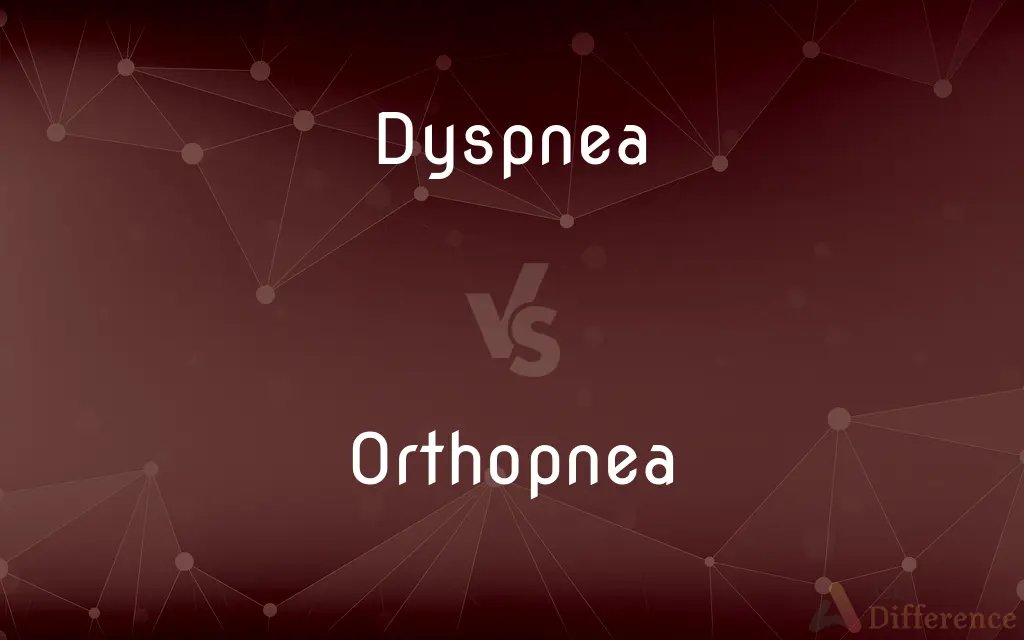Dyspnea vs. Orthopnea — What's the Difference?
By Maham Liaqat & Fiza Rafique — Updated on March 15, 2024
Dyspnea is the general term for difficult or labored breathing, while orthopnea refers specifically to breathlessness when lying flat, relieved by sitting or standing.

Difference Between Dyspnea and Orthopnea
Table of Contents
ADVERTISEMENT
Key Differences
Dyspnea, commonly known as difficulty breathing or shortness of breath, is a symptom that can be caused by various conditions ranging from mild to severe. It is the sensation of breathlessness or inadequate breathing and can occur during rest or physical activity. On the other hand, orthopnea is a type of dyspnea that specifically occurs when an individual is lying down and is typically relieved by sitting or standing up. Orthopnea is often associated with heart failure but can be caused by other conditions as well.
While dyspnea can be a broad term describing any difficulty in breathing, orthopnea is more specific in its triggers and relief patterns. Dyspnea can manifest due to respiratory issues like asthma, COPD (Chronic Obstructive Pulmonary Disease), lung infections, as well as cardiac problems and severe anemia. Whereas, orthopnea is particularly indicative of left-sided heart failure, as lying down increases venous return to the heart, exacerbating pulmonary congestion.
Individuals experiencing dyspnea might describe it as a feeling of being smothered, tightness in the chest, or an intense need for air, which can occur in various positions and situations. In contrast, those with orthopnea can specifically pinpoint their discomfort to being in a horizontal position, finding relief upon elevation of the head or torso, which differentiates it from general dyspnea.
Assessment of dyspnea focuses on identifying the underlying cause, which can involve a range of diagnostic tests, including pulmonary function tests, imaging, and blood work, depending on the suspected origin of the symptom. For orthopnea, the evaluation might include similar tests but with a particular focus on cardiac function, given its strong association with heart conditions.
Treatment for dyspnea varies widely based on the underlying cause but may include medications, oxygen therapy, and lifestyle modifications to manage the condition causing breathlessness. For orthopnea, treatment often targets the management of heart failure or other specific causes, with strategies including diuretics to reduce fluid buildup, medications to improve heart function, and positional therapy to alleviate symptoms.
ADVERTISEMENT
Comparison Chart
Definition
Difficulty in breathing, can occur at rest or during activity.
Difficulty in breathing that specifically occurs when lying flat.
Causes
Respiratory diseases, cardiac issues, anemia, etc.
Primarily associated with heart failure, but can be due to other conditions.
Symptoms
General breathlessness, tightness in chest, needing air.
Breathlessness relieved by sitting or standing up.
Diagnosis
Pulmonary function tests, imaging, blood work based on cause.
Focused on cardiac evaluation, alongside general tests.
Treatment
Based on underlying cause: medications, oxygen, lifestyle changes.
Management of heart failure, diuretics, positional therapy.
Compare with Definitions
Dyspnea
May occur in different situations, both at rest and during physical exertion.
Even at rest, his dyspnea was evident, indicating a potential heart issue.
Orthopnea
Breathlessness when lying down, relieved by sitting or standing.
To alleviate her orthopnea, she slept with extra pillows.
Dyspnea
Requires a thorough medical evaluation to determine the cause.
Her dyspnea was diagnosed as a symptom of pulmonary embolism.
Orthopnea
Requires positional adjustment for relief.
Orthopnea forced him to sleep in a recliner.
Dyspnea
Can signal various underlying health issues.
Dyspnea in asthma is triggered by allergens or exercise.
Orthopnea
Can be a critical symptom in diagnosing cardiac issues.
His orthopnea was so severe that it prompted immediate cardiac evaluation.
Dyspnea
A symptom that can be both acute and chronic.
Chronic dyspnea may suggest a long-term condition like COPD.
Orthopnea
Often indicative of heart failure.
The patient's orthopnea was a key symptom leading to the diagnosis of left-sided heart failure.
Dyspnea
A general term for difficulty breathing or shortness of breath.
After climbing stairs, she experienced severe dyspnea.
Orthopnea
Managed with treatments targeting fluid balance and heart function.
Diuretics significantly improved her orthopnea symptoms.
Dyspnea
Difficulty in breathing, often associated with lung or heart disease and resulting in shortness of breath. Also called air hunger.
Orthopnea
Orthopnea or orthopnoea is shortness of breath (dyspnea) that occurs when lying flat, causing the person to have to sleep propped up in bed or sitting in a chair. It is commonly seen as a late manifestation of heart failure, resulting from fluid redistribution into the central circulation, causing an increase in pulmonary capillary pressure.
Dyspnea
Difficult or labored respiration; shortness of breath.
Orthopnea
Alternative spelling of orthopnoea
Dyspnea
Difficult or labored respiration
Orthopnea
Form of dyspnea in which the person can breathe comfortably only when standing or sitting erect; associated with asthma and emphysema and angina pectoris
Common Curiosities
How does orthopnea differ from dyspnea?
Orthopnea is a specific type of dyspnea that occurs when lying flat and is relieved by sitting or standing, often linked to heart failure.
What is dyspnea?
Dyspnea is the sensation of breathing difficulty, ranging from mild discomfort to severe breathlessness, occurring in various conditions.
What are the common causes of orthopnea?
The most common cause of orthopnea is heart failure, though other conditions that affect breathing or the heart can also cause it.
Can dyspnea be a sign of a serious condition?
Yes, dyspnea can indicate serious underlying health issues, including cardiac diseases, respiratory conditions, or severe anemia.
How is orthopnea diagnosed?
Diagnosis may involve cardiac evaluations, imaging studies, and monitoring symptoms in different positions.
How is dyspnea treated?
Treatment for dyspnea depends on its cause and may include medications, oxygen therapy, and lifestyle adjustments to manage the underlying condition.
Can orthopnea be prevented?
Preventing orthopnea involves managing the underlying causes, such as controlling heart failure or other contributing conditions.
Can lifestyle changes alleviate dyspnea?
Yes, lifestyle changes, including weight management, quitting smoking, and regular exercise, can help manage or reduce dyspnea.
Is orthopnea always related to heart failure?
While heart failure is a primary cause, orthopnea can also result from other conditions affecting the heart or lungs.
Does dyspnea affect sleep?
Yes, dyspnea can significantly affect sleep quality, particularly if it worsens in certain positions or due to nighttime symptoms of the underlying condition.
Can anxiety cause dyspnea?
Yes, anxiety can cause or worsen dyspnea through hyperventilation or panic attacks, adding a psychological component to breathlessness.
Are there any specific exercises for dyspnea relief?
Breathing exercises and pulmonary rehabilitation can be effective in managing dyspnea, especially when caused by respiratory conditions.
Is orthopnea treatable?
Yes, orthopnea can be treated by addressing the underlying cause, such as improving heart function or managing fluid buildup.
What should I do if I experience sudden dyspnea?
Sudden onset of dyspnea should be treated as a medical emergency, as it can indicate a serious condition requiring immediate attention.
Share Your Discovery

Previous Comparison
Internship vs. Apprenticeship
Next Comparison
Bachelorship vs. BachelorhoodAuthor Spotlight
Written by
Maham LiaqatCo-written by
Fiza RafiqueFiza Rafique is a skilled content writer at AskDifference.com, where she meticulously refines and enhances written pieces. Drawing from her vast editorial expertise, Fiza ensures clarity, accuracy, and precision in every article. Passionate about language, she continually seeks to elevate the quality of content for readers worldwide.














































